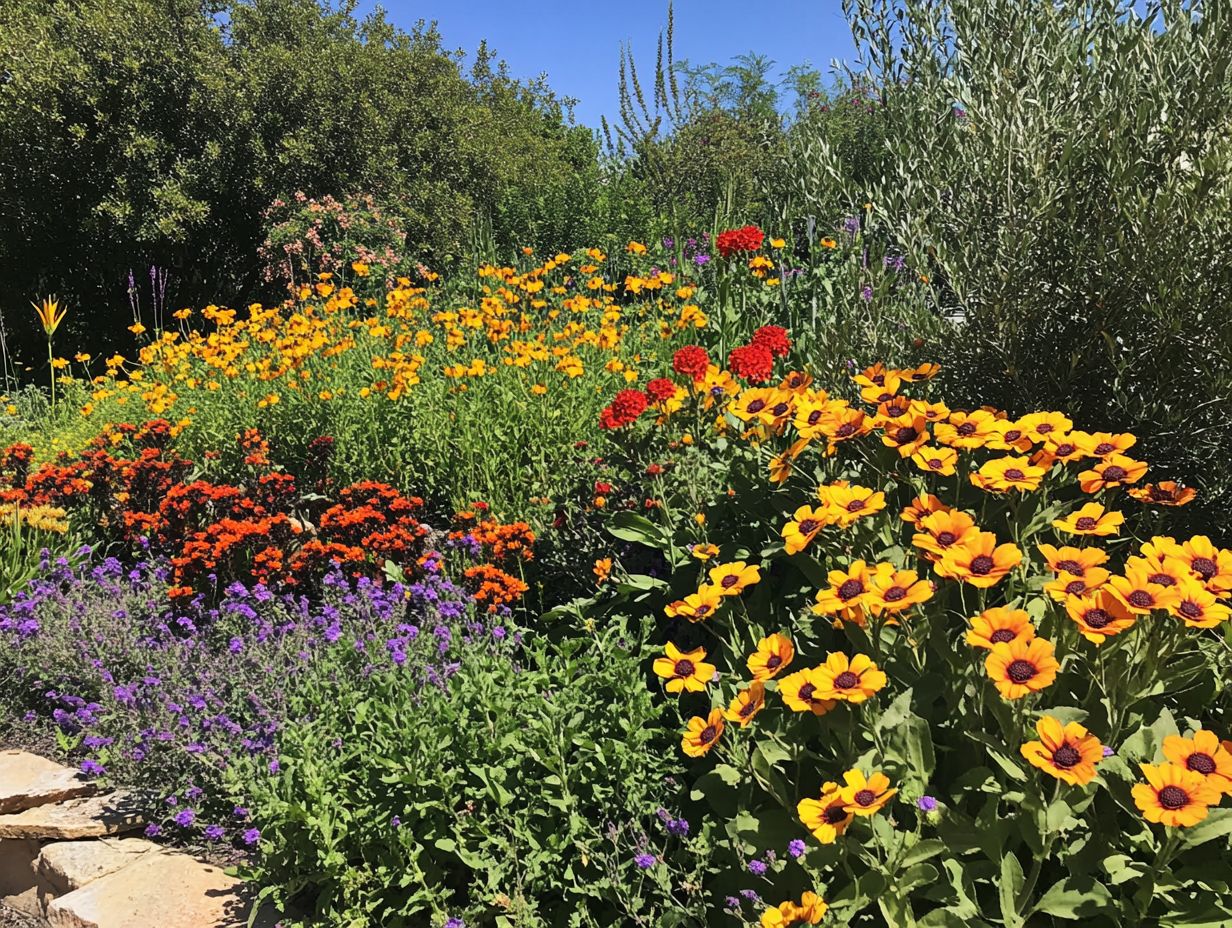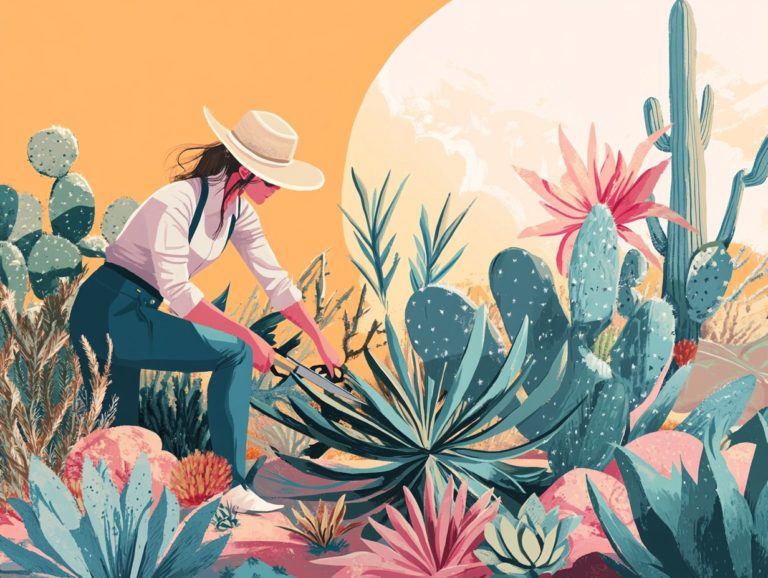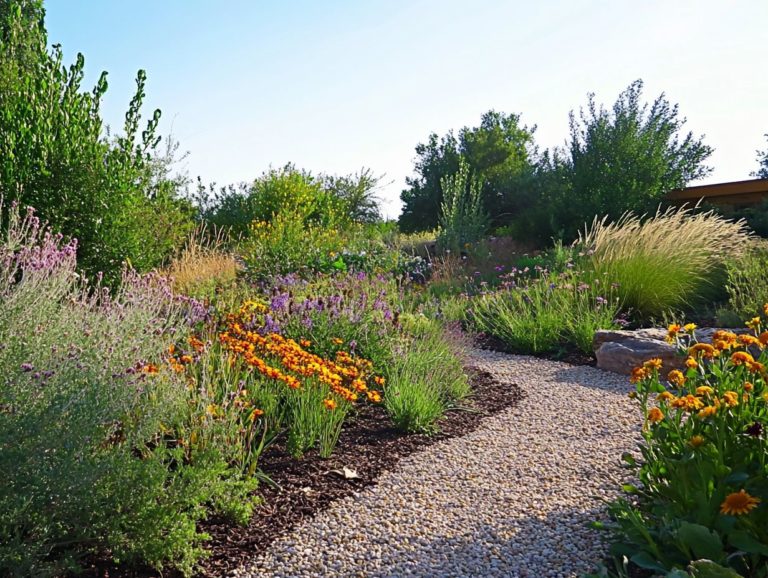What Are the Most Colorful Drought-Resistant Plants?
Drought-resistant plants present an ideal solution for your garden and landscape, especially in regions where water scarcity is a concern. These amazing plants don’t just save water; they bring your garden to life with stunning colors!
Explore the myriad benefits of incorporating drought-resistant plants, from their environmental advantages to the cost savings they bring. You’ll also discover five colorful drought-resistant plants that can infuse life into your garden while thriving in dry environments!
Contents
- Key Takeaways:
- Benefits of Using Drought-Resistant Plants
- Factors to Consider When Choosing Drought-Resistant Plants
- Top 5 Most Colorful Drought-Resistant Plants
- Frequently Asked Questions
- What are the most colorful drought-resistant plants?
- What makes a plant drought-resistant?
- Do drought-resistant plants require any special care?
- Can drought-resistant plants be grown in all climates?
- Are there any colorful drought-resistant plants that can be grown indoors?
- Are there any benefits to growing drought-resistant plants?
Key Takeaways:
- Drought-resistant plants offer a variety of environmental and economic benefits, making them a sustainable choice for gardening.
- When choosing drought-resistant plants, consider your area’s climate and soil conditions to ensure successful growth.
- Some of the most colorful drought-resistant plants include Purple Coneflower, Blanket Flower, Lavender, Red Bird-of-Paradise, and Mexican Sunflower.

What are Drought-Resistant Plants?
Drought-resistant plants, often known as low-water plants, are your go-to allies for thriving in arid conditions (dry climates). They are perfectly suited for outdoor gardening, particularly in areas that face water scarcity. These plants generally prefer well-drained soil and possess an impressive ability to retain moisture, which means less frequent watering for you. Plus, they help promote the variety of plants and animals in an area by attracting native pollinators. Their unique shapes and vibrant colors provide striking visual appeal, enhancing your landscape s curb appeal while maintaining ecological integrity.
Beyond their aesthetic charm, these drought-tolerant species come equipped with specialized traits like deep root systems and waxy leaves that minimize water loss. By incorporating them into your landscaping, you can create sustainable outdoor spaces that withstand extreme weather and support local wildlife habitats. Supporting native pollinators such as bees and butterflies, they play a vital role in maintaining the ecosystem s balance.
Using drought-resistant plants will lower maintenance costs and reduce reliance on chemical fertilizers, contributing to a healthier environment overall.
Benefits of Using Drought-Resistant Plants
Incorporating drought-tolerant plants into your landscape can elevate your outdoor space into a stunning, low-maintenance haven that conserves water and enhances biodiversity. These resilient plants thrive beautifully under full sun exposure and require minimal care, making them a top choice for discerning landscapers and consultants committed to sustainable gardening practices.
By selecting a diverse array of flowering perennials and aromatic plants, you can craft a visually captivating garden that attracts beneficial insects and supports local wildlife.
Environmental and Economic Benefits
The environmental advantages of using drought-resistant plants extend beyond simple conservation; they significantly reduce water usage, minimize soil erosion, and foster healthier ecosystems. From an economic perspective, these low-water plants can elevate your property s curb appeal, boosting its value while simultaneously lowering maintenance costs for both homeowners and businesses.
Consulting with a garden expert can guide you in selecting the most suitable species for your climate, ensuring that your landscape thrives sustainably. Consider varieties like lavender, agave, and succulents not only are they striking to look at, but they also require minimal irrigation once established. By incorporating these plants, you can enjoy long-term financial benefits, such as lower water bills and decreased landscape maintenance, freeing up your resources for other priorities.
Moreover, embracing these sustainable practices can greatly reduce your carbon footprint by diminishing the dependence on chemical fertilizers and pesticides commonly used in traditional landscaping. By cultivating resilient gardens, you actively contribute to biodiversity, creating habitats for native wildlife and aligning with community initiatives aimed at promoting environmental sustainability.
Start your sustainable garden today and enjoy the beauty and savings!
Factors to Consider When Choosing Drought-Resistant Plants

When selecting drought-resistant plants for your garden, consider key factors. These include your local climate, soil conditions, and the look you want to achieve.
Understanding the specific environmental conditions of your area is essential. This knowledge helps you choose low-water plants that thrive in your landscape. It also allows you to assess the requirements for well-drained soil and necessary sunlight exposure.
Engaging with a professional landscaper can provide personalized insights. This ensures you make the best choices for your garden s success.
Climate and Soil Conditions
Understanding your local climate is vital for selecting the right drought-resistant plants. Different species have unique needs regarding temperature and rainfall. Knowing what works best in your area is essential.
The quality of your soil, especially how well it allows water to flow through, plays a crucial role in helping these low-water plants flourish. By choosing heat-loving blooms, you can enhance both the resilience and beauty of your landscape.
To assess your local conditions effectively, consider factors like humidity, wind patterns, and seasonal variations. Observing these elements helps you find plant families that thrive with minimal irrigation.
Conducting soil tests can reveal pH levels and nutrient content. This guides you toward plants that prefer specific conditions. By aligning the right species with your environmental observations, you can create a sustainable and vibrant garden showcasing beauty and ecological harmony.
Top 5 Most Colorful Drought-Resistant Plants
Incorporating vibrant, drought-resistant plants into your garden is a game-changer! Not only do they enhance beauty, but they also create a low-maintenance landscape that requires minimal watering.
These flowering perennials are designed to thrive in arid conditions. They showcase unique shapes and radiant colors that significantly enhance your outdoor space’s curb appeal.
Whether you’re working with a professional landscaper or embarking on your own gardening journey, consider these top five plant options to create a striking visual impact.
Plant #1: [Name and Description]
[Plant name] stands out as a top choice among drought-resistant plants. It’s celebrated for its aromatic qualities and ability to attract native pollinators. This low-water gem thrives in full sun, making it ideal for a vibrant garden that requires minimal upkeep.
With its striking flowers and lush foliage, this plant beautifies your space and provides a vital habitat for bees and butterflies. It flourishes best in well-draining soil and endures dry spells, making it superb for sustainable gardening practices. The fragrant blooms not only attract pollinators but also fill your outdoor area with a delightful scent.
Prioritizing biodiversity allows you to create eco-friendly landscapes that support crucial insect populations. This proves that beauty harmonizes with environmental stewardship.
Ready to explore more? Visit your local nursery or consult a landscaping expert to discover the best drought-resistant plants for your garden!
Plant #2: [Name and Description]
![Plant #2: [Name and Description]](https://droughtgrow.com/wp-content/uploads/2024/09/what-are-the-most-colorful-drought-resistant-plants-QF.jpeg)
[Plant name] transforms any garden into a captivating oasis, showcasing vibrant colors and striking shapes that are bound to turn heads. As one of the premier flowering perennials, it flourishes even in drought conditions and requires minimal care, making it an ideal choice for anyone aiming to craft a stunning, low-maintenance landscape.
This exceptional plant boasts unique foliage that draws the eye. It creates a lush backdrop for more delicate flowers.
Its remarkable adaptability to various soil types enhances its allure, allowing it to thrive in rocky, sandy, or clay soils. It thrives during dry spells, making it an excellent candidate for gardening with little water.
You ll find that this perennial not only attracts pollinators but also enriches biodiversity while requiring minimal water. This ensures that your garden design remains both beautiful and sustainable.
Plant #3: [Name and Description]
[Plant name] is a truly remarkable drought-resistant plant that s perfect for your warmer climate. With its heat-loving blooms and unique shapes, it s an outstanding choice for those who want to make a statement in their gardens.
This low-water plant thrives in full sun exposure, effortlessly adding texture and interest to your landscape. Its striking colors, ranging from deep reds to vibrant yellows, create stunning focal points or can be used in mass plantings for a harmonious blend.
This hardy species prefers well-drained soil and is perfectly suited for gardening with little water, where conserving water is key. Its adaptability means it flourishes even in poor soils, making it a top pick for landscape designers.
Not only does it enhance the visual appeal of your garden, but it also attracts pollinators, promoting a biodiverse environment that beautifully complements other plants.
Plant #4: [Name and Description]
[Plant name] is a remarkable asset to your low-maintenance landscape, celebrated for its resilience and its role in fostering biodiversity within your garden. This drought-resistant wonder thrives under various conditions, making it an excellent choice for attracting beneficial insects.
By offering a haven for pollinators like bees and butterflies, it significantly contributes to ecological health. The ideal growing conditions include well-draining soil and full to partial sunlight, making it versatile for diverse garden settings.
For optimal care, regular pruning is key; it promotes healthy growth and enhances flowering, ultimately supporting a rich variety of wildlife. Thanks to its hardy nature, once established, it requires less water, making it a sustainable choice for the eco-conscious gardener eager to enrich their backyard habitat.
Plant #5: [Name and Description]
[Plant name] serves as a versatile, drought-resistant gem that not only elevates your curb appeal but also nurtures a habitat for native pollinators. Its resilient nature allows it to thrive in arid conditions, positioning it as a valuable asset in your sustainable outdoor gardening endeavors.
This stunning plant features vibrant blooms and interesting foliage that will transform the aesthetic of any landscape. With its low-maintenance requirements, it demands minimal water and care, while playing a crucial role in supporting local ecosystems by attracting butterflies, bees, and other essential pollinators.
Incorporating such a plant into your garden design enhances the beauty of your home and contributes to biodiversity, making a meaningful impact on the environment. For homeowners aiming to create a stunning yet eco-friendly outdoor space, this plant is the perfect choice effortlessly blending elegance with ecological responsibility.
Frequently Asked Questions

What are the most colorful drought-resistant plants?
Some of the most colorful drought-resistant plants include succulents, cacti, lavender, yarrow, and coneflowers. To learn more about these resilient options, check out what are the most resilient drought-resistant plants. Each of these adds vibrant colors and unique textures to any garden space.
What makes a plant drought-resistant?
A drought-resistant plant survives and thrives in dry conditions with little to no watering. These plants adapt to retain moisture and can handle tough conditions.
Do drought-resistant plants require any special care?
Once established, drought-resistant plants need minimal care. Occasional watering can help them thrive during long dry spells.
Can drought-resistant plants be grown in all climates?
Some drought-resistant plants may struggle in extreme cold or heat. Research the specific plant’s needs to ensure it grows well in your climate.
Are there any colorful drought-resistant plants that can be grown indoors?
Yes! Brighten your indoor space with stunning succulents and lively cacti. These plants require minimal watering and add a delightful splash of color.
Are there any benefits to growing drought-resistant plants?
Growing drought-resistant plants saves you time and money on watering. They are low maintenance and can enhance the beauty of your garden or landscape.
Start your journey today by choosing vibrant drought-resistant plants for your home or garden!






